1994 PONTIAC GRAND-AM engine coolant
[x] Cancel search: engine coolantPage 183 of 274
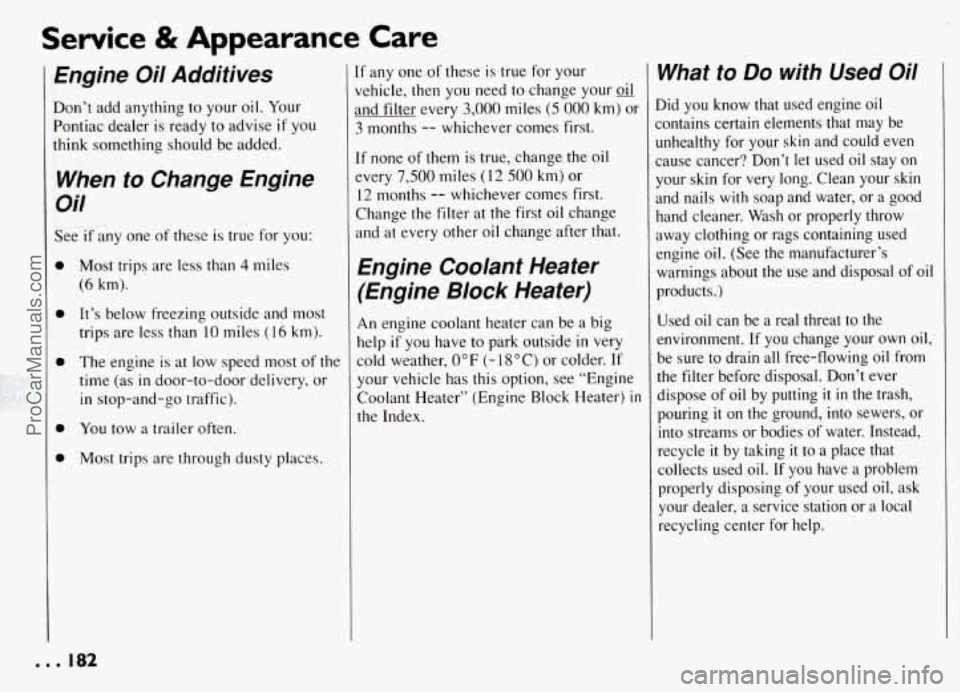
Service & Appearance Care
Engine Oil Additives
Don’t add anything to your oil. Your
Pontiac dealer is ready to advise
if you
think something should be added.
When to Change Engine
Oil
See if any one of these is true for you:
Most trips are less than 4 miles
(6 km).
It’s below freezing outside and most
trips are less than
10 miles ( 16 km).
The engine is at low speed most of the
time (as
in door-to-door delivery, or
in stop-and-go traffic).
You tow a trailer often.
Most trips are through dusty places.
[f any one of these is true for your
Vrehicle, then you need to change your oil
md filter every 3,000 miles (5 000 km) or-
3 months -- whichever comes first.
[f none of them is true, change the oil
=very 7,500 miles (12 500 km,) or
12 months -- whichever comes first.
Change the filter at the first oil change
and at every other
oil change after that.
Engine Coolant Heater
(Engine Block Heater)
An engine coolant heater can be a big
help if
you have to park outside in very
cold weather,
0°F (- 18OC) or colder. If
your vehicle has this option, see “Engine
Coolant Heater” (Engine Block Heater)
in
the Index.
What to Do with Used Oil
lid you know that used engine oil
:ontains certain elements that may be
Inhealthy
for your skin and could even
:awe cancer? Don’t let used oil stay on
your skin for very long. Clean your skin
md nails with soap and water, or a good
land cleaner. Wash or properly throw
lway clothing or rags containing used
mgine oil. (See the manufacturer’s
warnings about the use and disposal of oil
products.)
Used oil can be a real threat to the
mvironment.
If you change your own oil,
be sure to drain all free-flowing oil from
the filter before disposal. Don’t ever
dispose of oil by putting
it in the trash,
pouring
it on the ground, into sewers, or
into streams or bodies of water. Instead,
recycle
it by taking it to a place that
collects used
oil. If you have a problem
properly disposing of your used oil, ask
your dealer, a service station or
a local
recycling center for help.
... 182
ProCarManuals.com
Page 189 of 274

Service & Appearance Care
How to Check:
The proper fluid should be added if the
level is at or below the STEP mark on the
reservoir cap. See the instructions on the
reservoir cap.
Engine Coolant
The following explains your cooling
system and how to add coolant when
it is
low.
If you have a problem with engine
overheating, see “Engine Overheating”
in
the Index,
The proper coolant for your Pontiac will:
Give freezing protection down to
-34°F (-37°C).
Give boiling protection up to 262°F
( 128 “C).
Protect against rust and corrosion.
Help keep the proper engine
temperature.
Let the warning lights work as they
should.
What to Use
Use a mixture of one-half clean water
(preferably distilled) and one-half
antifreeze that meets “GM Specification
1825-M,” which won’t damage aluminum
parts.
You can also use a recycled coolant
conforming to GM Specification 1825-M
with a complete coolant flush and refill. If
you use this mixture, you don’t need to
add anything else. NOTICE:
If you use an improper coolant mix,
your engine could overheat and be
badly damaged. The repair cost
wouldn’t be covered by your
warranty. Too much water
in the
mix can freeze and crack the engine,
radiator, heater core and other parts.
... 188
ProCarManuals.com
Page 190 of 274
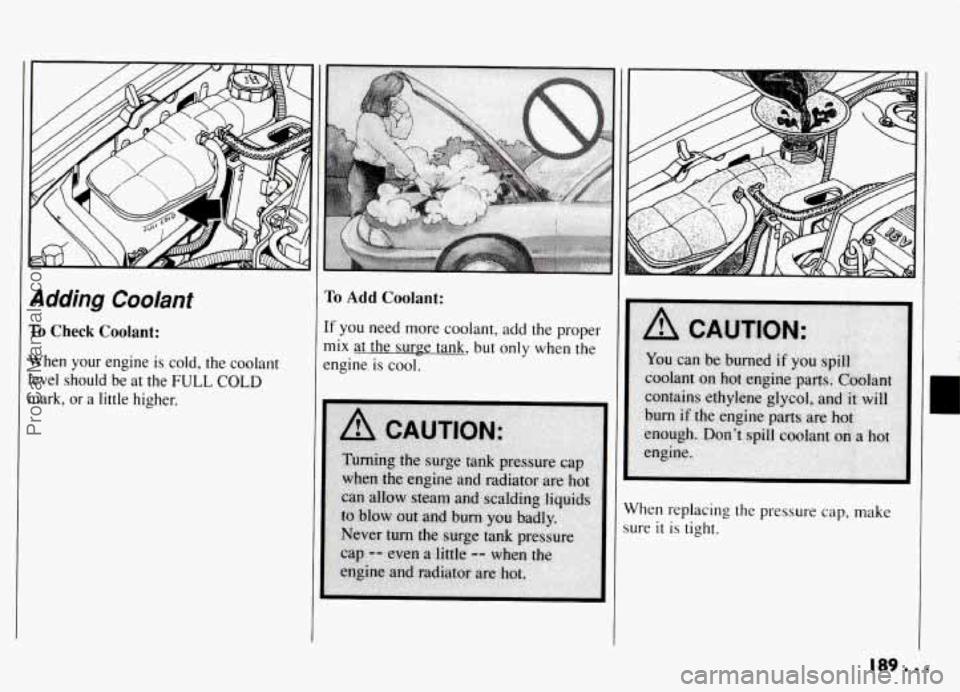
Adding Coolant
To Check Coolant:
When your engine is cold, the coolant
level should be at the
FULL COLD
mark, or a little higher.
To Add Coolant:
If you need more coolant, add the proper
mix at the surge tank, but only when the
engine
is cool.
‘hen replacing the pressure cap, make
Ire
it is tight.
C
189...
ProCarManuals.com
Page 191 of 274
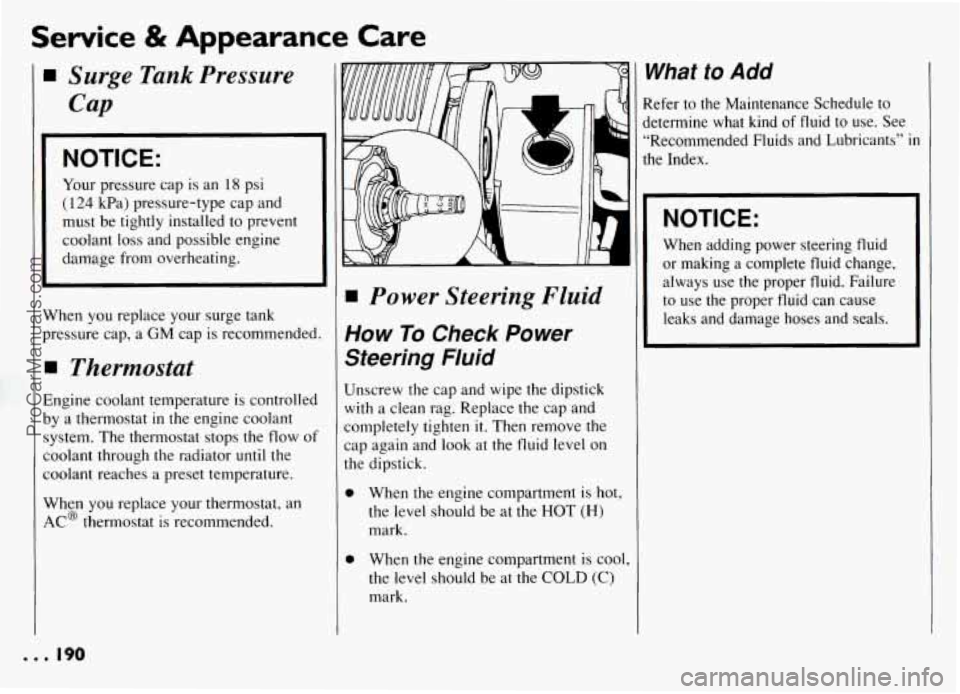
Service & Appearance Care
V
P
I
E
b
S’
C
C.
P
A
I Surge Tank Pressure
Cap
NOTICE:
Your pressure cap is an 18 psi
( 124 kPa) pressure-type cap and
must be tightly installed to prevent
coolant
loss and possible engine
damage from overheating.
irhen you replace your surge tank
ressure cap, a GM cap is recommended.
I Thermostat
lngine coolant temperature is controlled
y a thermostat in the engine coolant
ystem. The thermostat stops the flow
of
oolant through the radiator until the
oolant reaches a preset temperature.
Jhen you replace your thermostat, an
.C@ thermostat is recommended.
Power Steering Fluid
How To Check Power
Steering Fluid
Unscrew the cap and wipe the dipstick
with a clean rag. Replace the cap and
completely tighten
it. Then remove the
cap again and
look at the fluid level on
the dipstick.
0
0
When the engine compartment is hot,
the level should be at the HOT
(H)
mark.
When the engine compartment is cool,
the level should be at the
COLD (C)
mark.
1
I
1
What to Add
Refer to the Maintenance Schedule to
jetermine what kind
of fluid to use. See
“Recommended Fluids and Lubricants”
in
the Index.
NOTICE:
When adding power steering fluid
or making a complete fluid change,
always use the proper fluid. Failure
to use the proper fluid can cause
leaks and damage hoses and seals.
... 190
ProCarManuals.com
Page 231 of 274
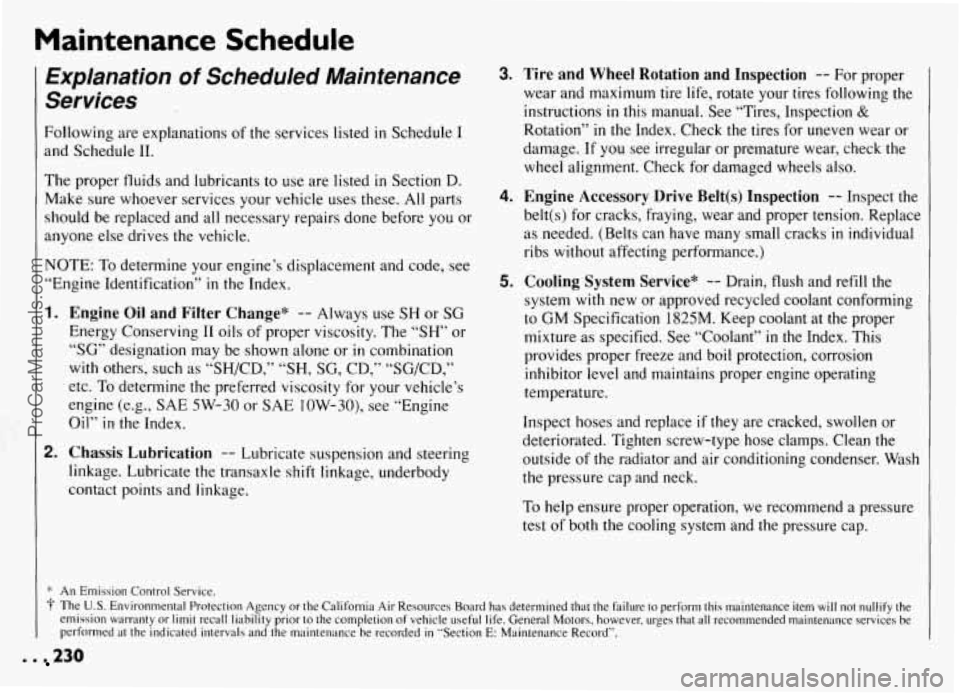
Maintenance Schedule
Explanation of Scheduled Maintenance
Services
Following are explanations of the services listed in Schedule I
and Schedule 11.
The proper fluids and lubricants to use are listed in Section D.
Make sure whoever services your vehicle uses these. All parts
should be replaced and all necessary repairs done before you or
anyone else drives the vehicle.
NOTE: To determine your engine’s displacement and code, see
“Engine Identification”
in the Index.
1.
2.
Engine Oil and Filter Change* -- Always use SH or SG
Energy Conserving I1 oils of proper viscosity. The “SH” or
“SG” designation may be shown alone or in combination
with others, such as “SH/CD,” “SH, SG, CD,” “SG/CD,”
etc. To determine the preferred viscosity for your vehicle’s
engine (e.g., SAE 5W-30 or SAE 10W-30), see “Engine
Oil”
in the Index.
Chassis Lubrication -- Lubricate suspension and steering
linkage. Lubricate the transaxle shift linkage, underbody
contact points and linkage.
3.
4.
5.
Tire and Wheel Rotation and Inspection -- For proper
wear and maximum tire life, rotate your tires following the
instructions
in this manual. See “Tires, Inspection &
Rotation” in the Index. Check the tires for uneven wear or
damage. If you see irregular or premature wear, check the
wheel alignment, Check for damaged wheels also.
Engine Accessory Drive Belt(s) Inspection -- Inspect the
belt(s) for cracks, fraying, wear and proper tension. Replace
as needed. (Belts can have many small cracks
in individual
ribs without affecting performance.)
Cooling System Service* -- Drain, flush and refill the
system with new or approved recycled coolant conforming
to
GM Specification 1825M. Keep coolant at the proper
mixture as specified. See “Coolant”
in the Index. This
provides proper freeze and boil protection, corrosion
inhibitor level and maintains proper engine operating
temperature.
Inspect hoses and replace if they are cracked, swollen or
deteriorated. Tighten screw-type hose clamps. Clean the
outside of the radiator and air conditioning condenser. Wash
the pressure cap and neck.
To help ensure proper operation, we recommend a pressure
test of both the cooling system and the pressure cap.
. . 230
ProCarManuals.com
Page 233 of 274
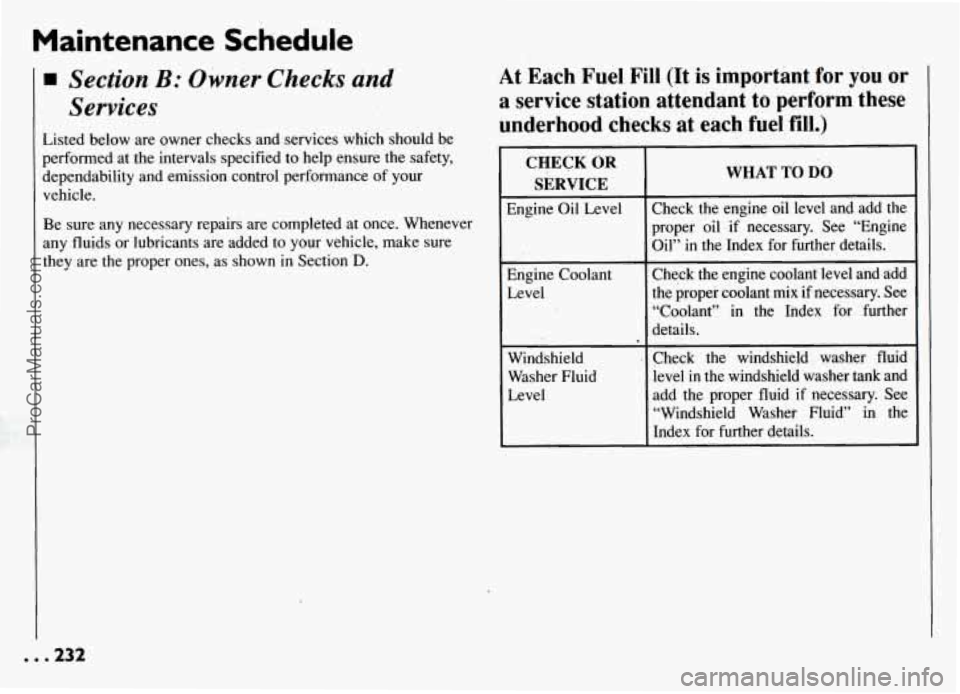
Maintenance Schedule
Section B: Owner Checks and
Services
Listed below are owner checks and services which should be
performed at the intervals specified to help ensure the safety,
dependability and emission control performance of your
vehicle.
Be sure any necessary repairs are completed at once. Whenever
any fluids or lubricants are added to your vehicle, make sure
they are the proper ones, as shown in Section
D.
At Each Fuel Fill (It is important for you or
a service station attendant to perform these
underhood checks at each fuel fill.)
CHECK OR
SERVICE
Engine Oil Level
Engine Coolant
Level
Windshield
Washer Fluid
Level
WHAT TO DO
Check the engine oil level and add the
proper oil
if necessary. See “Engine
Oil”
in the Index for further details.
Check the engine coolant level and add
the proper coolant mix if necessary. See
“Coolant” in the Index for further
details.
Check the windshield washer fluid
level in the windshield washer tank and
add the proper fluid
if necessary. See
“Windshield Washer Fluid” in the
Index for further details.
ProCarManuals.com
Page 239 of 274
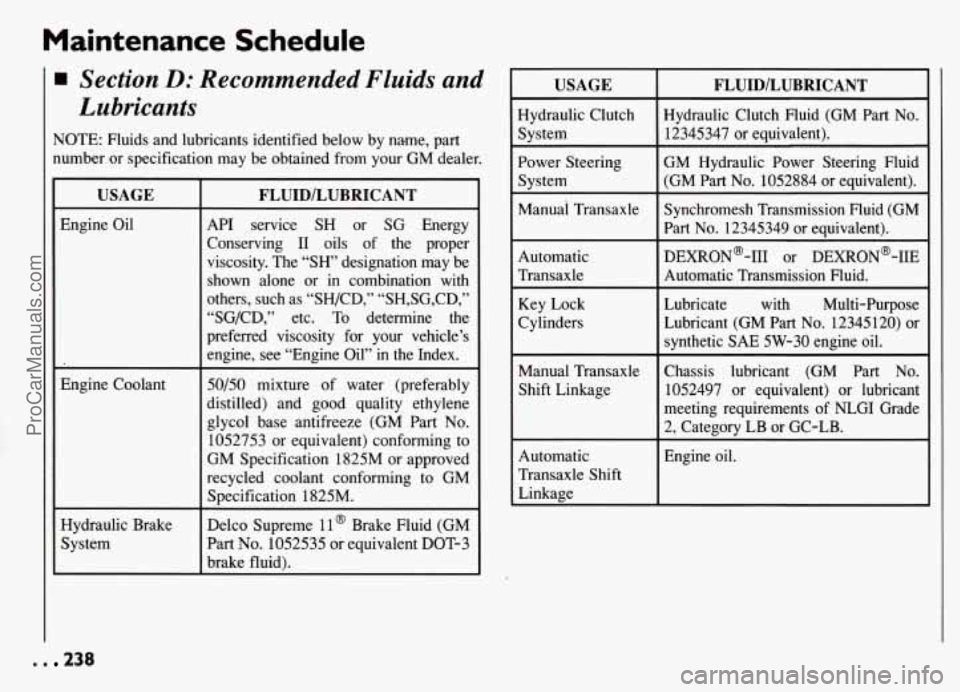
Maintenance Schedule
Section D: Recommended Fluids and
Lubricants
NOTE: Fluids and lubricants identified below by name, part
number or specification may be obtained from your GM dealer.
USAGE
Engine Oil
Engine Coolant
Hydraulic Brake
System
FLUIDlLUBRICANT
API service SH or SG Energy
Conserving I1 oils of the proper
viscosity. The
“SH’ designation may be
shown alone or
in combination with
others, such as “SH/CD,” “SH,SG,CD,”
“SG/CD,” etc. To determine the
preferred viscosity for your vehicle’s engine, see “Engine Oil” in the Index.
50/50 mixture of water (preferably
distilled) and good quality ethylene
glycol base antifreeze (GM Part No.
1052753 or equivaleot) conforming to
GM Specification 1825M or approved
recycled coolant conforming to GM
Specification 1825M.
Delco Supreme 11’ Brake Fluid (GM
Part No. 1052535 or equivalent DOT-3
brake fluid).
USAGE
Hydraulic Clutch
System
Power Steering
System
Automatic
Transaxle
Key Lock
Cylinders
Manual Transaxle
Shift Linkage
Automatic
Transaxle Shift
Linkage
FLUIDlLUBRICANT
Hydraulic Clutch Fluid (GM Part No.
12345347 or equivalent).
GM Hydraulic Power Steering Fluid
(GM Part No. 1052884 or equivalent). Synchromesh Transmission Fluid (GM
Part
No. 12345349 or equivalent).
DEXRON@-111 or DEXRON@-IIE
Automatic Transmission Fluid.
Lubricate with Multi-Purpose
Lubricant (GM Part
No. 12345 120) or
synthetic SAE 5W-30 engine oil.
Chassis lubricant (GM Part No.
1052497 or equivalent) or lubricant
meeting requirements of NLGI Grade
2, Category LB or GC-LB.
Engine oil.
. . 238
ProCarManuals.com
Page 264 of 274

Index
Adding
Brake Fluid ................. 192
Electrical Equipment
..... 107. 2 11
Engine Coolant
.......... 159. 189
Engine Oil
.................. 18 1
Hydraulic Clutch Fluid ........ 187
Power Steering Fluid
..... 190. 216
Transaxle Fluid
Automatic ........... 185. 215
Manual
.............. 187. 215
Windshield Washer Fluid
...... 191
Air Bag Readiness Light .......... 22
Air Bag (Supplemental Restraint
System - SRS) ................. 21
Air Cleaner .................... 183
Air Conditioner
................ 103
Alcohol. Driving Under the
Influence of .................. 120
Alcohol
in Gasoline ......... 17 1. 172
Aluminum Wheels. Cleaning ...... 208
Antenna. Fixed
Mast ............ 118
Antifreeze
..................... 188
Anti-Lock Brake System (ABS)
... 123
Anti-Lock Brake System
Warning Light ................. 99
Appearance Care and Materials
.... 204
Ashtray and Lighter
.............. 86
Audio Systems
................. 106
AM/FM Stereo Radio ......... 108
AM/FM Stereo Radio
with
Cassette Player ............. 109
AM/FM Stereo Radio with
Cassette Player and Graphic
Equalizer
.................. 11 1
AM/FM Stereo Radio with
Compact Disc Player ........ 11 3
Care of Audio Systems
........ 11 7
Delco LOC II@
.............. 115
Radio Reception. For the Best
. . 117
Setting the Clock
............. 107
Automatic Door Locks ............ 48
Automatic Lap-Shoulder Belt
(see “Safety Belts”)
Automatic Transaxle
Adding Fluid ............ 185. 215
Checking Fluid
.............. 184
Shifting
..................... 59
Starting Your Engine
........... 56
Battery .................. 148. 194
Jump Starting
........... 148. 194
Rundown Protection
........... 80
Voltmeter
.................... 97
BBB Auto Line
................ 245
Blizzard. If You’re Caught In a
.... 137
Block Heater. Engine
......... 58. 182
Blowout. Tire
.................. 16 1
Brakes
....................... 123
Adjustment ................. 193
Anti-Lock Brake System (ABS)
. 123
Brake Pedal Travel
........... 193
Fluid
...................... 191
Master Cylinder ............. 191
Parking
..................... 66
Rear Drums
................. 192
Replacement
................ 193
Warning Light
................ 98
Wear Indicators
.............. 192
Brakes. Anti-Lock .............. 123
Brake System Warning Light
....... 98
Anti-Lock Brake System
....... 99
Standard Brakes
.............. 99
Brakenramaxle Shift Interlock
..... 69
Warning Light
................ 99
Braking
....................... 123
Braking in Emergencies
.......... 125
,‘Break-in", New Vehicle
Braking Technique .............. 123
Normal Driving ............... 54
When Towing a Trailer ........ 141
Buckling Up (see “Safety Belts”)
Bulb Replacement
Fog Lights .............. 196. 217
Headlight
............... 195. 217
Taillight
................ 196. 217
Capacities & Specifications ...... 215
Carbon Monoxide
in Exhaust . . 70. 138
Cassette Tape Player (see “Audio
Center Passenger Position ......... 27
Chains. Safety
................. 143
Chains. Tire
................... 203
Systems”) C
263 ...
ProCarManuals.com